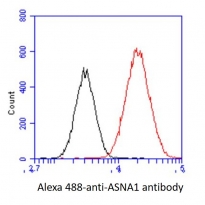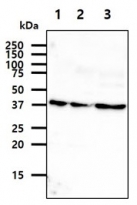ARG57134
anti-ASNA1 antibody [2A1]
anti-ASNA1 antibody [2A1] for Flow cytometry,Western blot and Human
概述
| 产品描述 | Mouse Monoclonal antibody [2A1] recognizes ASNA1 |
|---|---|
| 反应物种 | Hu |
| 应用 | FACS, WB |
| 宿主 | Mouse |
| 克隆 | Monoclonal |
| 克隆号 | 2A1 |
| 同位型 | IgG2b, kappa |
| 靶点名称 | ASNA1 |
| 抗原物种 | Human |
| 抗原 | Recombinant fragment around aa. 1-348 of Human ASNA1 |
| 偶联标记 | Un-conjugated |
| 別名 | EC 3.6.-.-; GET3; ARSA-I; Arsenite-stimulated ATPase; ATPase ASNA1; hARSA-I; hASNA-I; Transmembrane domain recognition complex 40 kDa ATPase subunit; ARSA1; TRC40; ASNA-I; Arsenical pump-driving ATPase |
应用说明
| 应用建议 |
|
||||||
|---|---|---|---|---|---|---|---|
| 应用说明 | * The dilutions indicate recommended starting dilutions and the optimal dilutions or concentrations should be determined by the scientist. |
属性
| 形式 | Liquid |
|---|---|
| 纯化 | Purification with Protein A. |
| 缓冲液 | PBS (pH 7.4), 0.02% Sodium azide and 10% Glycerol. |
| 抗菌剂 | 0.02% Sodium azide |
| 稳定剂 | 10% Glycerol |
| 浓度 | 1 mg/ml |
| 存放说明 | For continuous use, store undiluted antibody at 2-8°C for up to a week. For long-term storage, aliquot and store at -20°C. Storage in frost free freezers is not recommended. Avoid repeated freeze/thaw cycles. Suggest spin the vial prior to opening. The antibody solution should be gently mixed before use. |
| 注意事项 | For laboratory research only, not for drug, diagnostic or other use. |
生物信息
| 数据库连接 | |
|---|---|
| 基因名称 | ASNA1 |
| 全名 | arsA arsenite transporter, ATP-binding, homolog 1 (bacterial) |
| 背景介绍 | This gene represents the human homolog of the bacterial arsA gene, encoding the arsenite-stimulated ATPase component of the arsenite transporter responsible for resistance to arsenicals. This protein is also a central component of a transmembrane domain (TMD) recognition complex (TRC) that is involved in the post-translational delivery of tail-anchored (TA) proteins from the cytosol to the endoplasmic reticulum (ER). It recognizes and selectively binds the TMD of TA proteins in the cytosol, and delivers them to the ER for insertion. [provided by RefSeq, Oct 2011] |
| 生物功能 | ATPase required for the post-translational delivery of tail-anchored (TA) proteins to the endoplasmic reticulum. Recognizes and selectively binds the transmembrane domain of TA proteins in the cytosol. This complex then targets to the endoplasmic reticulum by membrane-bound receptors, where the tail-anchored protein is released for insertion. This process is regulated by ATP binding and hydrolysis. ATP binding drives the homodimer towards the closed dimer state, facilitating recognition of newly synthesized TA membrane proteins. ATP hydrolysis is required for insertion. Subsequently, the homodimer reverts towards the open dimer state, lowering its affinity for the membrane-bound receptor, and returning it to the cytosol to initiate a new round of targeting (By similarity). May be involved in insulin signaling. [UniProt] |
| 预测分子量 | 39 kDa |
检测图片 (2) Click the Picture to Zoom In
-
ARG57134 anti-ASNA1 antibody [2A1] FACS image
Flow Cytometry: HeLa cell line stained with ARG57134 anti-ASNA1 antibody [2A1] at 2-5 µg for 1x10^6 cells (red line). Secondary antibody: Goat anti-Mouse IgG Alexa fluor 488 conjugate. Isotype control antibody: Mouse IgG (black line).
-
ARG57134 anti-ASNA1 antibody [2A1] WB image
Western blot: 40 µg of 1) HeLa, 2) 293T, and 3) MCF7 cell lysates stained with ARG57134 anti-ASNA1 antibody [2A1] at 1:1000.







